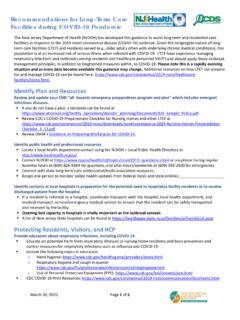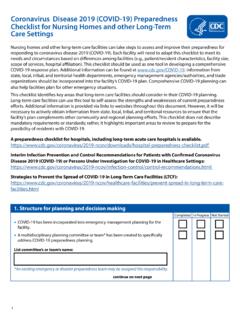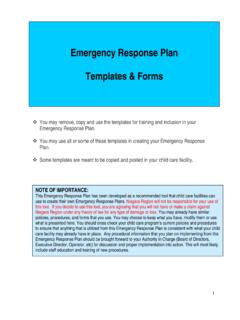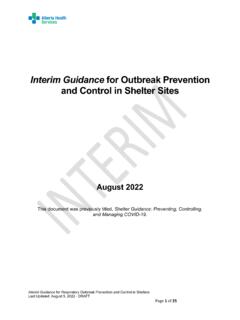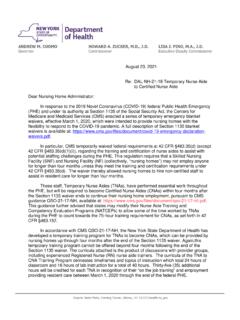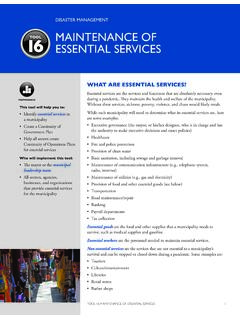Transcription of CMS Manual System
1 CMS Manual System Department of Health & Human Services (DHHS) Pub. 100-07 State Operations Provider Certification Centers for Medicare & Medicaid Services (CMS) Transmittal: 204 Date: April 16, 2021 SUBJECT: Revisions to the State Operations Manual (SOM) Appendix Z - Emergency Preparedness I. SUMMARY OF CHANGES: This Transmittal includes revisions based on recent federal regulation changes via (CMS 3346 F) and is a follow up to memo QSO 20-07 released on December 20, 2019. In addition to updates on the interpretive guidelines, this update also provides additional guidance on emerging infectious diseases.
2 We are making changes to Appendix Z to reflect lessons learned and additional guidance related to pandemic preparedness as a result of the COVID-19 public health emergency. NEW/REVISED MATERIAL - EFFECTIVE DATE: April 16, 2021 IMPLEMENTATION DATE: April 16, 2021 The revision date and transmittal number apply to the red italicized material only. Any other material was previously published and remains unchanged. However, if this revision contains a table of contents, you will receive the new/revised information only, and not the entire table of contents. II.
3 CHANGES IN Manual INSTRUCTIONS: (N/A if Manual not updated.) (R = REVISED, N = NEW, D = DELETED) (Only One Per Row.) R/N/D CHAPTER/SECTION/SUBSECTION/TITLE R Appendix Z/Introduction R Appendix Z/E-0001 R Appendix Z/E-0003 R Appendix Z/E-0004 R Appendix Z/E-0006 R Appendix Z/E-0007 R Appendix Z/E-0008 R Appendix Z/E-0009 R Appendix Z/E-0010 R Appendix Z/E-0013 R Appendix Z/E-0015 R Appendix Z/E-0016 R Appendix Z/E-0017 R Appendix Z/E-0018 R Appendix Z/E-0019 R Appendix Z/E-0020 R Appendix Z/E-0021 R Appendix Z/E-0022 R Appendix Z/E-0023 R Appendix Z/E-0024 R Appendix Z/E-0025 R Appendix Z/E-0026 R Appendix Z/E-0027 R Appendix Z/E-0028 R Appendix Z/ PACE - NON-CITABLE (No)
4 Assigned tags) Reference Only (PACE) R Appendix Z/E-0029 R Appendix Z/E-0030 R Appendix Z/E-0031 R Appendix Z/E-0032 R Appendix Z/E-0033 R Appendix Z/E-0034 R Appendix Z/E-0035 R Appendix Z/E-0036 R Appendix Z/E-0037 R Appendix Z/E-0038 R Appendix Z/E-0039 R Appendix Z/E-0041 R Appendix Z/E-0042 R Appendix Z/E-0044 III. FUNDING: No additional funding will be provided by CMS; contractor activities are to be carried out within their FY 2020 operating budgets. IV. ATTACHMENTS: Business Requirements X Manual Instruction Confidential Requirements One-Time Notification Recurring Update Notification Introduction (Rev.
5 204, Issued: 04- 16-21; Effective: 04-16-21, Implementation: 04- 16-21) The Medicare and Medicaid Programs; Emergency Preparedness Requirements for Medicare and Medicaid Participating Providers and Suppliers Final Rule (81 FR 63860, Sept. 16, 2016) ( Final Rule ) establishes national emergency preparedness requirements for participating providers and certified suppliers to plan adequately for both natural and man-made disasters, and coordinate with Federal, state, tribal, regional and local emergency preparedness systems. The Final Rule also assists providers and suppliers to adequately prepare to meet the needs of patients, clients, residents, and participants during disasters and emergency situations, striving to provide consistent requirements across provider and supplier-types, with some variations.
6 The emergency preparedness Final Rule is based primarily off of the hospital emergency preparedness Condition of Participation (CoP) as a general guide for the remaining providers and suppliers, then tailored based to address the differences and or unique needs of the other providers and suppliers ( inpatient versus out-patient providers). The requirements are focused on three key essentials necessary for maintaining access to healthcare during disasters or emergencies: safeguarding human resources, maintaining business continuity, and protecting physical resources.
7 The interpretive guidelines and survey procedures in this appendix have been developed to support the adoption of a standard all- hazards emergency preparedness program for all certified providers and suppliers while similarly including appropriate adjustments to address the unique differences of the other providers and suppliers and their patients. Successful adoption of these emergency preparedness requirements will enable all providers and suppliers wherever they are located to better anticipate and plan for needs, rapidly respond as a facility, as well as integrate with local public health and emergency management agencies and healthcare coalitions response activities and rapidly recover following the disaster.
8 While the use of healthcare coalitions are encouraged, this may not always be feasible for all providers and suppliers. For facilities participating in coalitions, the level of participation is not specified. However, if facilities use healthcare coalitions to conduct exercises or assist in their efforts for compliance, this should be documented and in writing. The 2016 Emergency Preparedness Final Rule emphasized that healthcare facilities should continue to engage their healthcare coalitions and state hospital preparedness program (HPP) coordinators for training and guidance.
9 We encourage healthcare facilities , particularly those in neighboring geographic areas, to collaborate and build relationships that will allow facilities to share and leverage resources. For additional information, please visit Applicability and Format of this Appendix Because the individual regulations for each specific provider and supplier share a majority of standard provisions, we have developed this Appendix Z to provide consistent interpretive guidance and survey procedures located in a single document Unless otherwise indicated, the general use of the terms facility or facilities in this Appendix refers to all 17 provider and suppliers, specifically Ambulatory Surgical Centers (ASCs); Critical Access Hospitals (CAHs).
10 Clinics, Rehabilitation Agencies, and Public Health Agencies as Providers of Outpatient Physical Therapy and Speech Language Pathology Services (OPT/OSP); Community Mental Health Centers (CMHCs); Comprehensive Outpatient Rehabilitation facilities (CORFs); End-Stage Renal Disease (ESRD) facilities ; Home Health Agencies (HHAs); Hospices; Hospitals; Intermediate Care facilities for Individuals with Intellectual Disabilities (ICF/IID); Long-Term Care (LTC) facilities ; Organ Procurement Organizations (OPOs); Psychiatric Residential Treatment facilities (PRTFs);Programs of All-Inclusive Care for the Elderly (PACE); Religious Nonmedical Health Care Institutions (RNHCIs); Rural Health Clinics (RHCs) and Federally Qualified Health Centers (FQHCs); and, Transplant Programs.










